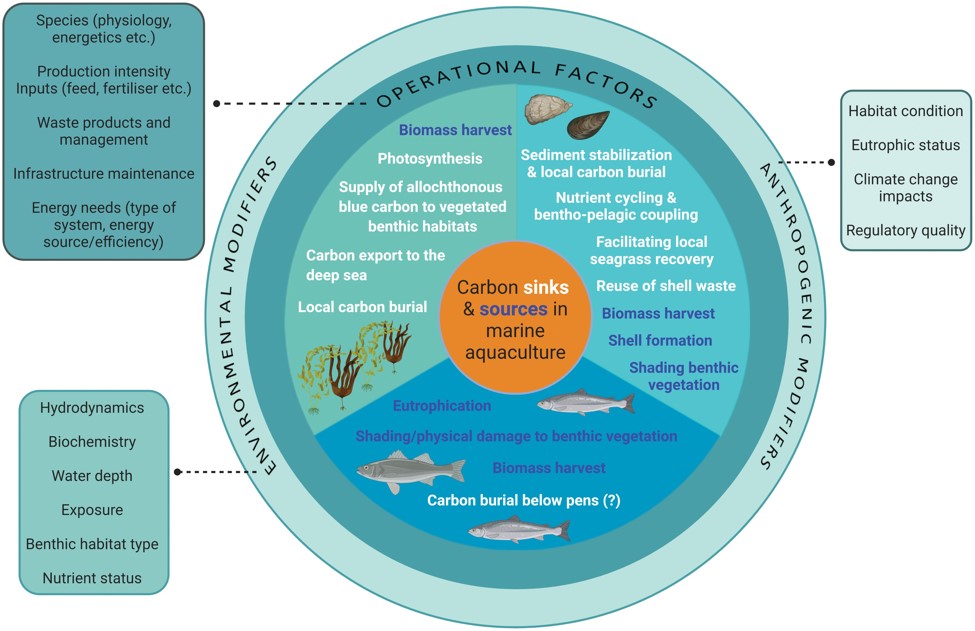Climate solution

Aquaculture is one industry that can actively reduce greenhouse gases, a report has found. Here’s why.
Seafood from marine farms using the right practices represents a climate-friendly option for consumers. So says a joint study by the University of Adelaide and The Nature Conservancy (TNC). Climate-Friendly Seafood: The Potential for Emissions Reduction and Carbon Capture in Marine Aquaculture, published in Bioscience, makes the case that aquaculture could be influential in actively reducing the drivers of climate change, and even has the potential to achieve zero or negative emissions.
The study looked at how greenhouse gas (GHG) emissions and carbon sinks associated with fed finfish, seaweed and bivalve shellfish farming could be mitigated, and concluded that the hunch that eating farmed seafood could benefit the planet can be substantiated by science.
Using their findings, researchers outlined actionable, planning and operational changes for industry and governments, to help mitigate GHG emissions and facilitate carbon sequestration during on-farm production.
“We’ve used the results of our analysis to carve out clear, climate-friendly principles for the marine farming industry and governments,” Dr Alice Jones, Industry Research Fellow at the School of Biological Sciences, University of Adelaide, and the study’s lead co-author, says.
Aquaculture has already overtaken fisheries as the main provider of aquatic animal products, and now accounts for 52% of global consumption. Marine aquaculture (mariculture) is responsible for 37.5% of this production and 97% of the world’s seaweed harvest. Over the last 50 years, the industry has grown at a rate of 7.5% per year and is predicted to increase significantly over the coming decades.
As a result, the researchers surmise: “Responsible development of aquaculture is a key strategy to meet growing food demand, nutritional needs and to achieve food security within planetary boundaries.”
The report also says: “[The] ecosystem approach to aquaculture will be critical to mitigating the climate impacts of a scaleup in mariculture.”
“If these principles are adopted, this study could be game-changing, not just for marine applications, but for other types of food production as well,” Heidi Alleway, Global Aquaculture Scientist at The Nature Conservancy and a lead co-author says. “We see an opportunity here, to shape aquaculture to be at the forefront of addressing climate change impacts from food production.”
The report notes that all aspects of aquaculture, from feed production through farm practices to processing and transportation, are implicated in emitting GHGs. Better practices are needed to reduce emissions, it says, but the greatest opportunities for high-volume reductions are in the upstream and downstream parts of the supply chain. As such, improvements are suggested to make feed production and supply and post-harvest transportation more climate-friendly.
The researchers also found that interactions between mariculture operations and surrounding marine environments influence GHG emissions, particularly through the degradation of seafloor habitats and the associated release of stored carbon as environmental GHG emissions. The loss of seagrass habitats due to excess nutrient inputs from fish farming is given as an example of aquaculture causing damage to an important “blue” carbon sink. Conservative estimates consider that this damage adds as much as 16% to the total annual global emissions from aquaculture.
Importantly, the paper points out that lifecycle assessments for GHG emissions from mariculture do not typically account for environmental GHG emissions, whereas they are included in assessments for land farming.
The report’s guidance on developing aquaculture/mariculture in a sustainable manner suggests that adding seaweed culture to existing operations can help to mitigate environmental degradation and lead to operations becoming emission neutral. However, it also points out that the ultimate fate of the end product is key for achieving positive carbon outcomes.
For seaweed aquaculture to be an effective source of carbon sequestration, the report suggests that the siting of farms is crucial, as well as the ultimate use of seaweed. Moving farms further offshore for example, could result in greater fuel use in vessels used to service seaweed lines.
Large amounts of carbon are stored in seaweed biomass, but once a plant is harvested, that carbon is either released or transferred up the food chain. Turning seaweed into commodities, such as bio-plastics or bioproducts to improve soil health, therefore offers a more climate-friendly outcome. Studies are underway to permanently sequester carbon in seaweed by depositing it in the deep sea, although research is needed to investigate the impact on deep sea ecosystems.
Recommendations for fish farmers to reduce or avoid GHG emissions include: making improvements in feed use and efficiency; switching to renewable fuel and clean energy sources; using durable materials for farm infrastructure; and improved siting of operations to reduce nutrient inputs and waste.
The report advises that consumers can help reduce emissions by being more conscious of where seafood comes from and by eat more farmed shellfish and seaweed. These products have no emissions associated with feed production, although packing and shipping contribute to overall emissions.

“Addressing climate change requires all hands on deck, and food production has historically accounted for a major share of global greenhouse gas emissions,” Robert Jones, Global Lead for Aquaculture at The Nature Conservancy and a co-author of the study, says.
He added: “We are calling on the aquaculture sector to further its commitment to join the fight to address climate change. This study shows aquaculture has a major role to play and provides a road map for implementation.”
Looking to the future, the researchers hope to help in aligning the industry with carbon accounting, offsetting and crediting schemes focused on achieving demonstrable GHG emissions reduction or carbon sequestration. This process is currently hampered by a lack of specific policy frameworks and knowledge gaps, which prevent effective carbon accounting.



